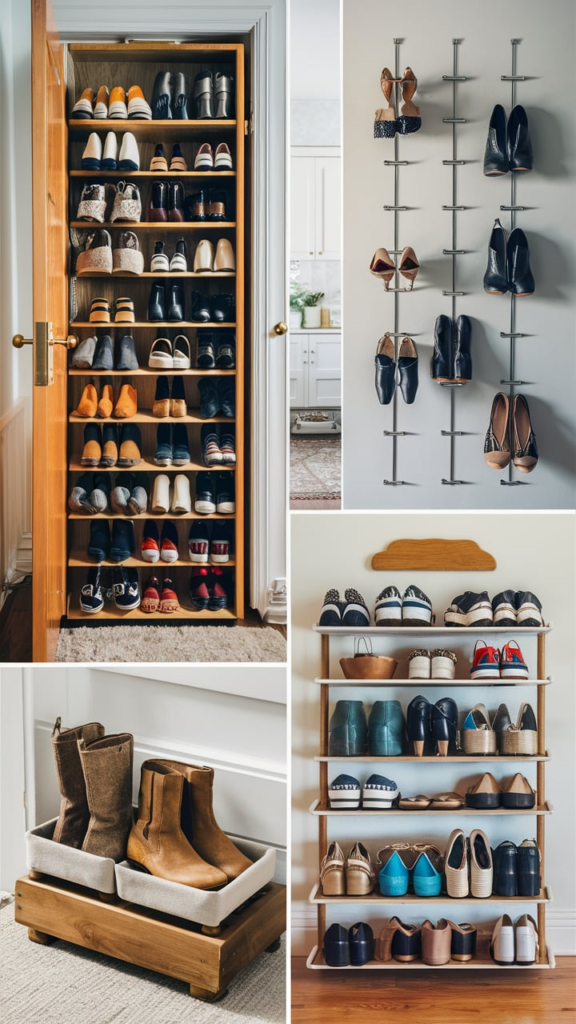
The Importance of Entryway Organization
The entryway is the first impression of your home. It’s not just a transition space but a functional area where everyday activities begin and end. Keeping this area organized is crucial for maintaining a sense of order and a welcoming atmosphere. One common challenge in entryway organization is shoe storage. Shoes scattered around can create a cluttered appearance, making it challenging to find the right pair when needed.
Overview of Shoe Storage Solutions
Effective shoe storage solutions can transform your entryway from chaotic to chic. This article explores 15 innovative shoe storage ideas that cater to different needs and spaces. From wall-mounted racks to personalized designs, these solutions will help you optimize your entryway, making it functional and aesthetically pleasing. Whether you have a large entryway or a compact space, there’s one to fit your needs and style.
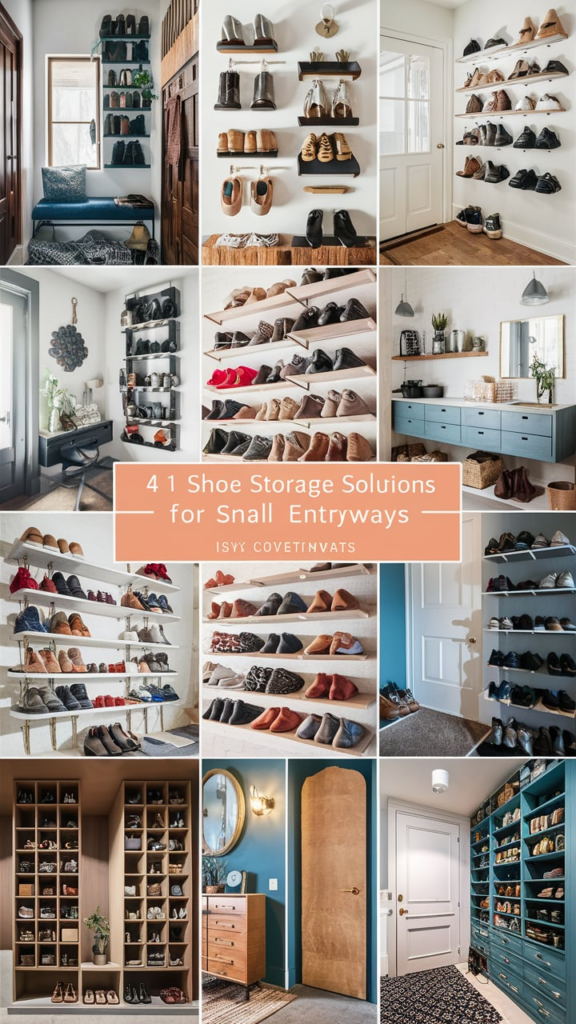
Table of Contents
Wall-Mounted Shoe Racks
Space-Saving Solutions
Wall-mounted shoe racks are an excellent choice for those seeking to maximize their entryway space. By utilizing vertical space, these racks help keep your shoes organized and off the floor, freeing up valuable floor area. Wall-mounted racks come in various styles, from simple shelves to elaborate cubby systems, allowing you to choose one that best fits your entryway and storage needs.
Best Materials for Durability
When selecting a wall-mounted shoe rack, consider materials that combine durability with style. Wood is a popular choice for its classic look and sturdiness. Options like oak, walnut, or bamboo not only support the weight of multiple pairs of shoes but also add a touch of warmth to your entryway. On the other hand, metal racks offer a sleek, modern appearance and are often more lightweight. Steel or aluminum racks are highly durable and can handle heavier loads without bending or warping.
Installation Tips
Proper installation ensures your wall-mounted shoe rack is functional and safe. Start by locating the wall studs using a stud finder; this ensures that the screws are anchored securely. For heavier racks, use wall anchors to distribute the weight more evenly. Make sure to level the rack before drilling to avoid a tilted appearance. If you’re unsure about instayou’ren, consider hiring a professional to ensure the rack is mounted securely and safely.

Shoe Cabinets with Bench Seating
Combining Functionality with Comfort
Shoe cabinets with bench seating offer a dual-purpose solution combining practical storage and added comfort. These units are designed to provide a place to sit while putting on or taking off shoes, making them an excellent choice for busy households. The bench top is typically cushioned or upholstered, offering a comfortable resting spot, while the cabinet below neatly organizes your footwear.
Style and Design Options
Shoe cabinets with bench seating come in various styles and designs to suit different tastes and entryway aesthetics. Traditional wooden designs exude warmth and classic appeal, while modern options may feature sleek finishes like gloss or matte. Some cabinets come with built-in shoe compartments, adjustable shelves, or pull-out drawers, allowing customized storage solutions. For a more contemporary look, consider units with a combination of open shelves and closed compartments, which can add a stylish element to your entryway.
Choosing the Right Size
Size is an essential factor when selecting a shoe cabinet with bench seating. Measure your entryway to determine how much space you have available. Ensure the cabinet is proportionate to the area and doesn’t overwhelm it. Consdoesn’te number of shoes you need and choose a cabinet with sufficient storage capacity. Also, ensure the bench seating is comfortable and easy to use.
Additional Features
Some shoe cabinets with bench seating come with extra features like built-in storage for accessories, such as umbrellas or hats, making them even more versatile. Look for options with a top that can double as a display area for decorative items, such as vases or photo frames, to enhance the overall look of your entryway.

Under-Bench Shoe Storage
Maximizing Small Spaces
Under-bench shoe storage is an ideal solution for entryways with limited space. This type of storage efficiently uses the area beneath a bench or seating unit, turning an often-overlooked spot into valuable storage space. Utilizing the space under a bench allows you to keep shoes organized and accessible without taking up additional floor space, which is perfect for compact entryways or small apartments.
Types of Under-Bench Storage
- Built-In Drawers: These offer a clean and seamless look, with drawers sliding out to reveal neatly organized shoes. Built-in drawers are perfect for hiding away shoes and maintaining a tidy appearance. They are instrumental if you prefer a more enclosed and discrete storage solution.
- Open Shelving: For a more accessible option, open shelving under the bench allows easy shoe access. This type of storage can be simple shelves or cubbies, providing a straightforward and practical solution. It’s also easier to see and reIt’sve shoes quickly.
- Baskets and Bins: Adding baskets or bins under the bench can help contain shoes and other entryway essentials. Baskets can be used for loose items, like sports shoes or slippers, and they often add a decorative touch to the entryway. Bins are also suitable for keeping everything organized and out of sight.
Design and Aesthetic Considerations
When incorporating under-bench shoe storage, consider the overall design of your entryway. Opt for sleek, minimalist designs with clean lines if you have a modern style. For a more traditional look, choose wooden benches with ornate detailing. Ensure the bench and storage materials and finishes complement each other and blend with the existing decor.
Installation Tips
Ensure that the under-bench storage is installed securely and functions smoothly. If you add built-in drawers oyou’reves, ensure they are level and adequately anchored to avoid wobbling or instability. For baskets or bins, choose sizes that fit well within the space and are easy to pull out for access.
Maintenance and Cleaning
Keep your under-bench storage organized by regularly decluttering and wiping down surfaces. Shoes should be cleaned before storage to avoid dirt buildup, and baskets or bins should be emptied and washed as needed.

Shoe Cubbies and Organizers
Versatile Storage Solutions
Shoe cubbies and organizers offer a flexible and efficient way to store shoes in your entryway. These solutions come in various forms, from modular cubby systems to specialized organizers designed to fit different needs and spaces. They help keep shoes neatly arranged, making it easier to find the right pair and maintain an organized entryway.
Customizing Your Storage
- Modular Cubby Systems: Modular cubbies are a versatile option that allows you to customize the storage according to your needs. These systems consist of individual units arranged in different configurations to fit your space. Modular cubbies are ideal for larger entryways or closets, where you can create a custom layout that suits your shoe collection.
- Tiered Organizers: Tiered organizers are another practical solution for storing shoes. They come with multiple levels or tiers, each designed to hold a pair of shoes. This type of organizer can be placed on a shelf or inside a closet, providing a clear and accessible view of your footwear. Tiered organizers are often adjustable, allowing you to modify the height between tiers to accommodate different shoe sizes.
- Stackable Cubbies: Stackable cubbies offer a space-efficient way to organize shoes vertically. These units can be stacked on each other to create a custom storage solution that fits your space. Stackable cubbies are available in various sizes and materials, including wood, metal, and plastic, making them suitable for multiple decor styles.
Design and Aesthetic Considerations
When choosing shoe cubbies and organizers, consider the design and materials that best match your entryway’s decor. Wooden cubbies offer an entryway look and can be stained or painted to match your furniture. Metal or wire organizers provide a sleek, modern appearance and are often more lightweight. Plastic options are budget-friendly and come in various colors and patterns.
Installation and Setup
Setting up shoe cubbies and organizers is generally straightforward. For modular and stackable systems, ensure the units are securely assembled and fit well within your space. When installing tiered organizers, check that they are level and stable to prevent tipping. Follow the manufacturer’s instructions and use the appropriate manufacturers for the best results.
Maintenance and Accessibility
Keep your cubbies and organizers clean by regularly dusting and wiping down surfaces. Organize shoes by type or size to make it easier to locate what you need. Periodically reassess your storage needs and adjust the arrangement to accommodate new shoes or changing preferences.

Over-the-Door Shoe Organizers
Easy and Affordable Options
Over-the-door shoe organizers are a popular choice for their convenience and cost-effectiveness. These organizers hang over the back of a door, utilizing otherwise unused vertical space to keep your shoes neatly arranged and accessible. They are handy for small entryways or apartments with limited floor space. They offer a practical solution for everyday shoe storage with ease of installation and budget-friendly price.
Types of Over-the-Door Organizers
- Pocket Organizers: Pocket-style over-the-door organizers feature clear or mesh pockets holding each pair of shoes. Each pocket is typically made of fabric or vinyl, allowing you to see the contents easily. Pocket organizers are versatile and can accommodate shoes from sneakers to flats. They are also great for storing small items like accessories or cleaning supplies.
- Shelved Organizers: Shelved over-the-door organizers have horizontal shelves that hold multiple pairs of shoes. These units are often made from wire or metal and provide a sturdy surface for shoes to rest on. They can handle heavier shoes and are ideal for those with more extensive shoe collections.
- Hanging Baskets: Hanging baskets can be used as over-the-door organizers for a more flexible approach. These baskets can be suspended from the door and adjusted to different heights. They provide a less rigid storage solution, allowing you to store shoes or other items more casually.
Design and Aesthetic Considerations
Over-the-door organizers come in various designs to suit different tastes and decor styles. Choose organizers with a simple design and neutral colors for a minimalist look. Consider organizers with patterned fabrics or stylish metal finishes if you prefer a more decorative approach. Ensure the organizer complements the overall aesthetic of your entryway while being functional.
Installation Tips
Installing an over-the-door shoe organizer is typically straightforward. Most models come with adjustable hooks or straps that fit over standard door sizes. Ensure the hooks or straps are securely attached, and the organizer hangs evenly. For heavier items, make sure the door can support the weight without warping or damaging it.
Maintenance and Organization
Clean your over-the-door organizer by wiping the pockets or shelves with a damp cloth. Regularly declutter the organizer to ensure it remains functional and organized. Group similar types of shoes together for easier access and avoid overloading the pockets or shelves to prevent damage.
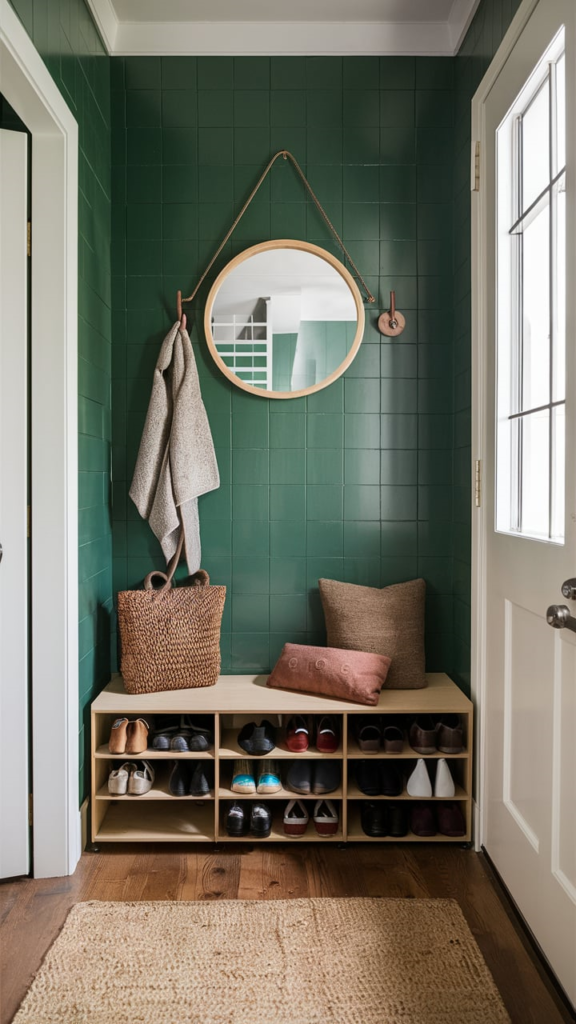
Stackable Shoe Racks
Flexibility and Expandability
Stackable shoe racks are a versatile and expandable solution for organizing your footwear. These racks are designed to be stacked on each other, allowing you to adjust the height and number of tiers based on your storage needs. This flexibility makes stackable racks ideal for various entryway sizes and shoe collections, from minor to extensive.
Types of Stackable Shoe Racks
- Wooden Stackable Racks: Wooden stackable racks provide a classic and sturdy storage solution. They are often made from hardwood or engineered wood, offering a robust structure that can hold multiple pairs of shoes. Wooden racks can be stained or painted to match your decor, making them a stylish addition to any entryway.
- Metal Stackable Racks: Metal stackable racks are known for their durability and modern look. Typically made from steel or aluminum, these racks are solid and lightweight, allowing them to hold substantial weight. Metal racks often feature a minimalist design, making them a good fit for contemporary spaces.
- Plastic Stackable Racks: Plastic stackable racks are a budget-friendly option offering easy assembly and maintenance. They come in various colors and designs, making them versatile for different decor styles. Plastic racks are also lightweight and resistant to moisture, which can be beneficial in humid environments.
Tips for Optimal Arrangement
- Determine the Height: Measure your available space and decide on the height of your stackable rack. Ensure enough room above the rack for easy access to the top tier. Adjust the height of each tier to accommodate different types of shoes, such as high heels or boots.
- Load Evenly: To maintain stability and prevent tipping, distribute the weight evenly across the rack. Place heavier shoes on the lower tiers and lighter ones on the upper tiers. Avoid overcrowding the rack, as this can cause deformation or damage over time.
- Secure the Racks: If you stack multiple racks, ensure they are securely aligned to prevent wobbling. Some models come with connectors or stabilizers to keep the stacks together. If not, consider using wall anchors or brackets for added stability.
Design and Aesthetic Considerations
Stackable shoe racks come in various styles to suit different tastes. Choose metal racks with clean lines and a minimalist design for a sleek, modern look. Wooden racks offer a warm, traditional appearance that can complement classic or rustic decor. Plastic racks in various colors can add a fun and vibrant touch to your entryway.
Maintenance and Cleaning
Regularly clean your stackable shoe rack to keep it looking its best. For wooden racks, dust frequently and use a wood cleaner to maintain the finish. Metal racks should be wiped down with a damp cloth to remove dust and dirt. Plastic racks can be cleaned with mild soap and water. Ensure the racks are completely dry before placing shoes back on them to prevent mold and mildew growth.

Rotating Shoe Racks
Maximizing Space Efficiency
Rotating shoe racks are an innovative storage solution designed to maximize space efficiency and provide easy access to your footwear collection. These racks feature a rotating mechanism that allows you to spin the rack to view and reach different tiers or compartments. This feature is handy in tight spaces where accessing shoes from a traditional rack might be challenging.
Types of Rotating Shoe Racks
- Freestanding Rotating Racks: Freestanding rotating racks are standalone units that can be placed anywhere in your entryway. They typically feature multiple tiers or shelves arranged around a central axis, allowing you to rotate the entire rack to access different levels. These racks often have a compact footprint, making them ideal for small spaces.
- Corner Rotating Racks: Corner rotating racks are designed to fit snugly into corner spaces, optimizing otherwise unused areas. These racks often have a triangular or wedge-shaped design, allowing them to utilize corner space effectively. The rotating feature makes it easy to access shoes from all rack sides.
- Wall-Mounted Rotating Racks: Wall-mounted rotating racks are attached directly to the wall and rotate horizontally. These racks save floor space and can be installed at a height that suits your needs. Wall-mounted options are great for entryways with limited floor area, as they keep the storage off the ground.
Design and Aesthetic Considerations
Rotating shoe racks come in various designs and materials to match different decor styles.
- Modern Designs: Choose rotating racks with sleek metal frames and minimalist designs for a contemporary look. These racks often feature clean lines and a polished finish, making them suitable for modern or industrial-style entryways.
- Traditional Designs: Wooden rotating racks offer a classic appearance and can add warmth to your entryway. Opt for racks with rich finishes and detailed craftsmanship to complement traditional or rustic decor.
- Compact and Functional Designs: For smaller spaces, consider rotating racks with compact designs that fit neatly into tight areas. These racks can be designed with space-saving features and efficient storage solutions.
Installation and Maintenance
- Installation: Position the unit in your desired location for freestanding rotating racks. Ensure that it is placed on a level surface to prevent wobbling. Wall-mounted racks require more effort; use a stud finder to locate wall studs and securely anchor the rack to avoid sagging or damage. Follow the manufacturer’s instructions for installation.
- Maintenance: Regular maintenance is essential to keeping the manufacturer’s rotating rack in good condition. Dust the surfaces regularly to prevent buildup. For wooden racks, use a wood cleaner to maintain the finish. Metal and plastic racks can be cleaned with a damp cloth. If necessary, occasionally lubricate the pivot points to ensure that the rotating mechanism is functioning smoothly.
Benefits of Rotating Shoe Racks
Rotating shoe racks offer several benefits, including easy access to all pairs of shoes, efficient use of space, and the ability to keep your entryway organized. The rotating feature lets you view and select shoes quickly without shuffling through a cluttered rack. Additionally, these racks help keep shoes off the floor, reducing clutter and maintaining a tidy appearance.
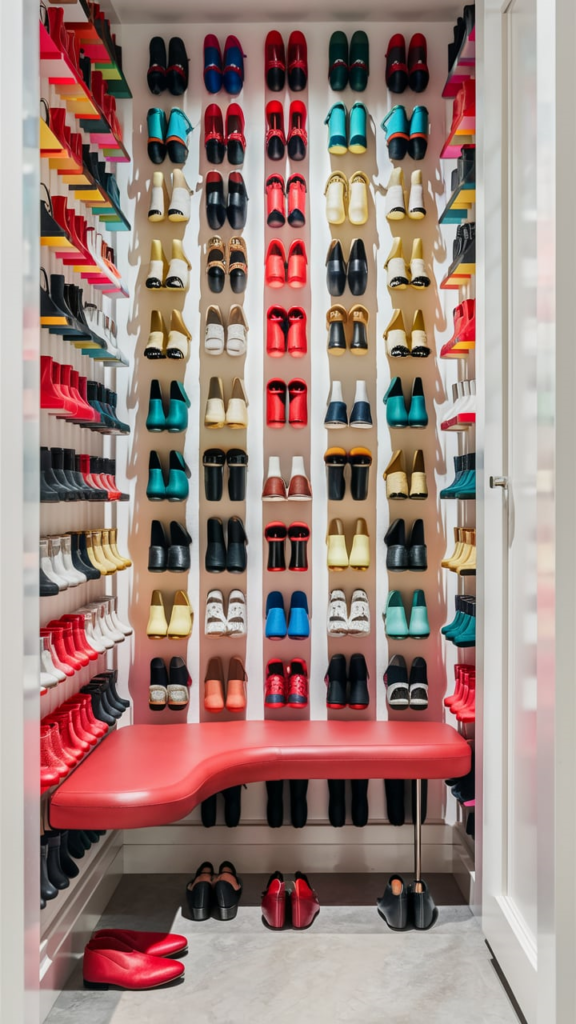
Shoe Storage Ottomans
Stylish and Functional Solutions
Shoe storage ottomans combine practicality with aesthetic appeal, offering a dual-purpose solution that adds seating and storage to your entryway. These versatile pieces of furniture feature a cushioned top that serves as a seat while providing hidden storage space for shoes and other essentials. Shoe storage ottomans are ideal for enhancing the functionality of your entryway without compromising on style.
Types of Shoe Storage Ottomans
- Upholstered Ottomans: Upholstered shoe storage ottomans come in various fabrics, including leather, velvet, and linen. They provide a comfortable seating surface and have hinged or lift-top lids to access the storage compartment. Upholstered options often feature decorative elements such as tufting or nailhead trim, adding a touch of elegance to your entryway.
- Bench Ottomans: Bench-style ottomans offer a more extended seating surface and can accommodate more storage space underneath. These ottomans are often rectangular and can seat multiple people. They usually have a hinged top or removable cushion to access the shoe storage area.
- Modular Ottomans: Modular Ottomans are customizable and can be rearranged to fit different spaces and needs. Some modular options come with built-in shoe compartments that can be added or removed based on your requirements. These versatile pieces can be adjusted to create a tailored storage solution for your entryway.
Design and Aesthetic Considerations
- Modern Designs: For a contemporary look, choose ottomans with sleek lines, minimalistic designs, and neutral colors. Modern ottomans often feature clean shapes and can be upholstered in faux leather or smooth fabrics for a polished appearance.
- Traditional Designs: Traditional shoe storage ottomans often feature classic details such as tufted upholstery, rolled arms, or carved legs. Opt for rich fabrics and wood accents to complement traditional or vintage decor.
- Eclectic Designs: If you prefer a more diverse look, consider ottomans with bold patterns, vibrant colors, or unique textures. These designs can serve as a statement piece in your entryway, adding character and interest to the space.
Installation and Placement
Shoe storage ottomans are generally easy to place and require minimal installation. Choose a location that provides convenient access while complementing the overall layout of your entryway. Ensure enough space around the ottoman for easy storage compartment opening and comfortable seating.
Maintenance and Care
- Upholstered Ottomans: Regularly vacuum or brush upholstered ottomans to remove dust and debris. Follow the manufacturer’s instructions for spills or stains, which may involve spot cleaning with specific fabric cleaners.
- Leather Ottomans: To maintain the manufacturer’s warranty and prevent cracking, clean ottomans with a leather conditioner or cleaner. Wipe off dust and dirt with a soft cloth.
- Wood Accents: If your ottoman features wooden elements, dust them regularly and apply furniture polish to keep the wood looking its best.
Benefits of Shoe Storage Ottomans
Shoe storage ottomans offer several advantages, including a combination of seating and storage, a clutter-free entryway, and added style to your space. They provide a convenient place to sit while putting on or taking off shoes, and the hidden storage helps keep your footwear organized and out of sight.

Floating Shelves for Shoes
Sleek and Modern Storage
Floating shelves offer a contemporary solution for shoe storage. They utilize wall-mounted platforms that seem to “float” without visible supports. These shelves provide a minimalist and elegant way to display and organize footwear “while, “keeping your entryway clutter-free. Their sleek design allows flexibility in arranging and customizing your shoe storage to fit your space and style.
Types of Floating Shelves
- Single Shelf Units: Single floating shelves are ideal for small spaces or creating a clean, uncluttered look. They can be mounted at various heights on the wall to accommodate different shoes, from high heels to sneakers. Single shelves work well for showcasing a few select pairs or providing additional closet storage.
- Multi-Tier Shelves: Multi-tier floating shelves have several horizontal layers mounted on the wall. These units provide ample space for organizing multiple pairs of shoes, making them suitable for more extensive collections. Multi-tier shelves allow you to create a visually appealing display while keeping your shoes easily accessible.
- Customizable Floating Shelves: Customizable floating shelves can be adjusted to fit specific needs and spaces. These systems may include modular components that can be rearranged or expanded. Customizable options are perfect for adapting to changing shoe collections or fitting irregular spaces.
Design and Aesthetic Considerations
- Modern and Minimalist: Choose floating shelves with clean lines and a simple design for a modern and minimalist look. Materials like glass, acrylic, or high-gloss finishes enhance the contemporary feel. Floating shelves in neutral colors or transparent materials blend seamlessly with various decor styles.
- Industrial and Rustic: Floating shelves with metal brackets or reclaimed wood can add an industrial or rustic touch to your entryway. These designs often feature raw or distressed finishes, complementing industrial or farmhouse decor.
- Custom Finishes: Floating shelves are available in various finishes and materials, including wood, metal, and laminate. Consider the existing decor of your entryway and choose a finish that matches or complements your furniture and design elements.
Installation Tips
- Wall Mounting: Ensure that floating shelves are securely mounted to the wall. A stud finder is used to locate wall studs and attach the shelves with appropriate hardware to support the weight of the shoes. Follow the manufacturer’s instructions for installation to ensure stability and safety.
- Height and Spacing: Mount shelves at the the manufacturer’s for accessing your shoes. Consider the height of the shoes and the amount of clearance needed between shelves. Allow enough space between tiers to accommodate different shoe types.
- Leveling: To avoid an uneven display, make sure the shelves are level when installed. Use a level tool to check alignment during installation.
Maintenance and Care
- Cleaning: Floating shelves can be cleaned with a damp cloth to remove dust and dirt. Use a glass cleaner to maintain a streak-free finish for glass or acrylic shelves. Wooden shelves may require occasional polishing to keep the wood looking fresh.
- Checking Stability: Periodically check the stability of the floating shelves to ensure they remain securely mounted. Tighten any loose screws or brackets as needed.
Benefits of Floating Shelves
Floating shelves offer numerous benefits, including a stylish and modern storage solution, a clutter-free entryway, and customizable space options. They allow easy access to your shoes while maintaining an organized and visually appealing display. Floating shelves can also enhance the overall aesthetic of your entryway, making them both functional and decorative.
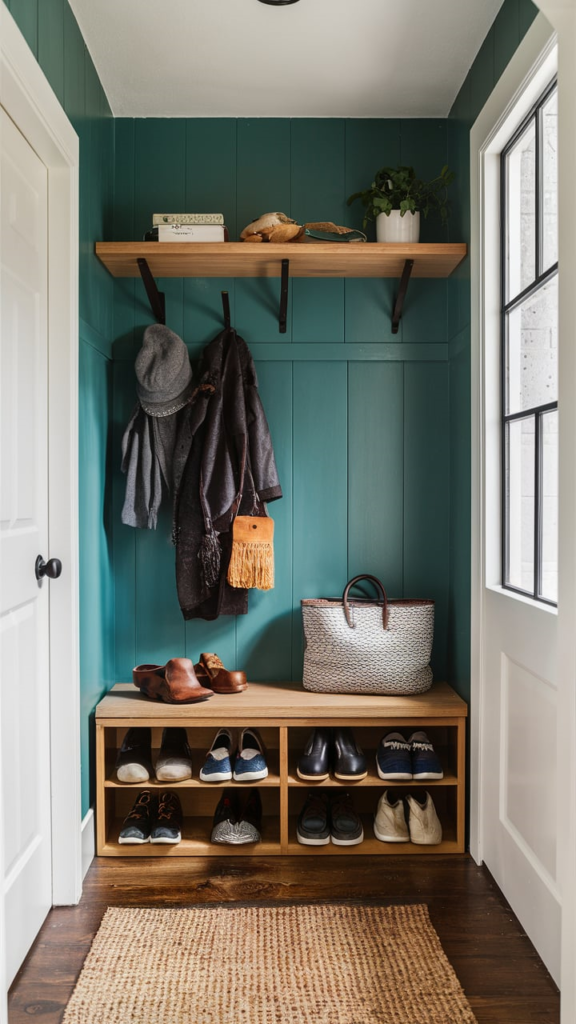
DIY Shoe Storage Ideas
Personalized and Cost-Effective Solutions
DIY shoe storage ideas offer a creative and cost-effective way to organize your footwear while adding a personal touch to your home. By repurposing materials or building custom solutions, you can create functional and stylish shoe storage that fits your needs and decor preferences. Here are some innovative DIY ideas for shoe storage that you can quickly implement at home.
1. Repurposed Wooden Crates
How-To: Wooden crates can be transformed into rustic shoe storage by stacking or mounting them on the wall. Sand and paint the crates to match your decor, and arrange them in a pattern that suits your space. For added functionality, you can add dividers or fabric liners.
Benefits: Wooden crates are versatile, allowing for various arrangements and configurations. They also add a charming, rustic look to your entryway or closet.
2. PVC Pipe Shoe Rack
How to create a unique shoe rack using PVC pipes. Cut the pipes into segments and assemble them into a grid or pyramid shape using PVC connectors. Paint or decorate the pipes to match your style. Secure the rack to the wall or use it as a freestanding unit.
Benefits: PVC pipe racks are lightweight, durable, and customizable. They offer a modern and industrial look while providing ample storage space.
3. Over-the-Door Shoe Organizer
How-To: Upcycle a standard over-the-door shoe organizer by adding fabric or decorative pockets. Customize the pockets to fit different types of shoes or accessories. You can also paint or add embellishments to match your entryway decor.
Benefits: Over-the-door organizers use vertical space, keeping shoes accessible while saving floor space. The customizable pockets allow for flexible storage options.
4. Pallet Shoe Rack
How to use wooden pallets to create a rustic shoe rack. Sand and stain the pallet, then mount it horizontally on the wall or place it on the floor. You can also add casters for mobility or stack multiple pallets for a taller rack.
Benefits: Pallets are a cost-effective and environmentally friendly material. They offer a rugged, industrial aesthetic and are easy to customize.
5. Shoe Storage Ottoman
How-To: Repurpose an old ottoman or upholstered bench to include shoe storage. Remove the top cushion and install a set of shelves or baskets underneath. Reupholster the ottoman if needed to refresh its appearance.
Benefits: A shoe storage ottoman combines seating with hidden storage, making it a practical and stylish addition to your entryway.
6. Ladder Shoe Rack
How to use an old wooden ladder to create a stylish shoe rack. Lean the ladder against the wall and use the rungs to store shoes. Paint or stain the ladder to fit your decor. You can also add baskets or trays on the rungs for additional organization.
Benefits: A ladder rack adds a vertical storage option with a chic, vintage look. It’s an easy project that uses materials you may already have.
7. Drawer Dividers
How-To: Convert old drawers or crates to shoe storage by adding dividers to create compartments. Paint or line the drawers with fabric for a finished look. Arrange the drawers in a stack or mount them on the wall.
Benefits: Drawer dividers help keep shoes organized and accessible. This solution is ideal for small spaces or closets.
8. Fabric Shoe Organizer
How-To: Sew a fabric shoe organizer with multiple pockets. Use durable fabric and add adjustable straps or Velcro to hang the organizer over a door or on a wall. Customize the size and number of pockets based on your needs.
Benefits: Fabric organizers are lightweight and easily customizable. They offer a flexible and portable storage solution.
9. Shoe Storage Bench
How-To: Build a custom storage bench with a cushioned top and open shelves underneath. Use the shelves to store shoes and add baskets or bins for smaller items. Choose wood or metal based on your style preferences.
Benefits: A storage bench provides seating and storage, making it a functional addition to your entryway or mudroom.
10. Floating Shelf Shoe Rack
How-To: Install floating shelves at varying heights on your wall to create a custom shoe rack. Space the shelves according to the size of your shoes and add decorative elements if desired.
Benefits: Floating shelves offer a modern and space-saving solution for shoe storage. They can be customized to fit any wall and decor style.
Tips for Successful DIY Shoe Storage
- Measure Your Space: Before starting your DIY project, measure the available space to ensure your shoe storage solution will fit properly.
- Choose the Right Materials: Select materials that suit your style and durability needs. Consider the weight and size of your shoes when choosing materials.
- Follow Safety Guidelines: Use appropriate tools and safety gear for DIY projects. Ensure that your storage solutions are securely mounted or assembled.
- Add Personal Touches: Customize your DIY storage with paint, fabric, or embellishments to match your home decor and personal style.
Benefits of DIY Shoe Storage
DIY shoe storage ideas offer the advantage of personalization, cost-effectiveness, and creativity. By creating your storage solutions, you can tailor them to your needs and preferences while adding a unique touch to your home.
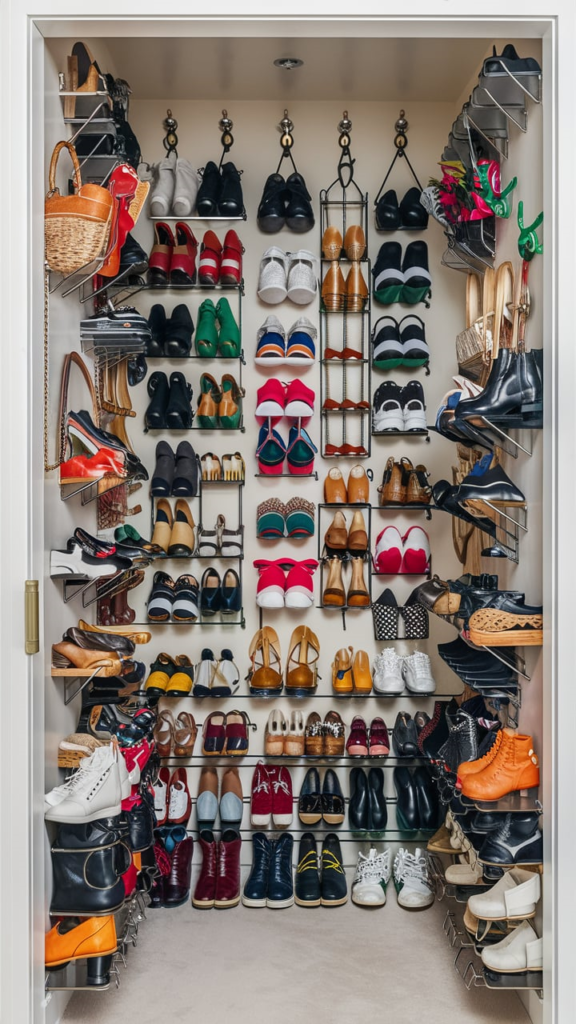
Shoe Storage Baskets and Bins
Versatile and Practical Solutions
Shoe storage baskets and bins are essential for maintaining an organized, clutter-free entryway or closet. They provide a flexible and practical way to store and organize shoes, helping to keep your space tidy while offering easy access to your footwear. Available in various styles, sizes, and materials, these storage solutions can be customized to fit your needs and decor.
Types of Shoe Storage Baskets and Bins
- Woven Baskets
How-To: Woven baskets are made from wicker, rattan, or fabric materials. They often come with handles for easy transport and can be placed on shelves or in cubbies. Choose baskets with an open weave for a more decorative look or fabric-lined options for a softer appearance.
Benefits: Woven baskets add a natural and stylish touch to your space. They are lightweight, easy to move, and available in various sizes to accommodate different types of shoes.
- Plastic Bins
How-To: Plastic bins are durable and often come with lids to remove dust and debris from your shoes. They are stackable, making them ideal for maximizing vertical space in closets or storage areas. Choose bins with clear sides for easy visibility of contents or opaque ones for a cleaner look.
Benefits: Plastic bins are practical for long-term storage and easy to clean. They are versatile and can be used in various settings, from entryways to closets.
- Fabric Storage Bins
How-To: Fabric bins are made from materials like canvas or polyester and can be folded when not in use. They are often used in conjunction with shelving units or cube organizers. Fabric bins come in various colors and patterns, allowing you to match them with your decor.
Benefits: Fabric storage bins are lightweight, collapsible, and customizable. They offer a soft and stylish storage solution that can easily blend with different decor styles.
- Metal Wire Baskets
How-To: Metal wire baskets are sturdy and often have a grid design that allows for ventilation. They are ideal for use in closets or on open shelves and can store a variety of items beyond shoes.
Benefits: Metal wire baskets are durable and provide a modern, industrial look. They are also easy to clean and maintain, making them a practical choice for active households.
Design and Aesthetic Considerations
- Matching Your Decor: Choose baskets and bins that complement the existing decor of your entryway or closet. Woven baskets and fabric bins can add warmth and texture, while metal wire and plastic bins offer a more contemporary look.
- Color and Pattern: Opt for colors and patterns that match your home’s color scheme. Neutral tones like gray, beige, or white can blend seamlessly with any decor, while bold colors and patterns make a statement.
- Size and Shape: Select baskets and bins that fit the dimensions of your storage space. Consider the size and type of shoes you need to store and choose appropriately sized containers.
Placement and Organization
- Shelves and Cubbies: Place baskets and bins on shelves or inside cubbies for easy access. Labels or tags can help identify the contents of each container, especially if you have multiple bins.
- Closets and Entryways: In closets, stack bins to maximize space and keep frequently used shoes within easy reach. In entryways, place baskets near the door for quick and convenient storage.
- Under-Bed Storage: For additional storage options, use low-profile bins or baskets that slide under the bed. This solution is ideal for seasonal footwear or items that are not frequently used.
Maintenance and Care
- Cleaning: Regularly clean baskets and bins to remove dust and dirt. Fabric bins can be spot-cleaned or washed according to the manufacturer’s instructions. Plastic containers can be wiped down with a damp cloth, while metal baskets can be cleaned with a brush.
- Inspecting for Wear: Check baskets and bins periodically for signs of wear or damage. Replace any cracked, torn, or otherwise compromised to ensure they continue to provide adequate storage.
Benefits of Shoe Storage Baskets and Bins
Shoe storage baskets and bins offer flexibility, organization, and easy access to your footwear. They help keep your space tidy and allow for customization based on your storage needs and decor preferences. You can create a more organized and visually appealing environment by incorporating these practical storage solutions into your home.

Under-Stair Shoe Storage
Maximizing Space with Style
Under-stair shoe storage is an innovative solution that utilizes the often overlooked space beneath stairs. This area, which might otherwise be wasted, can be transformed into a functional and stylish storage area for footwear. You can turn this space into a practical and attractive shoe storage solution with creativity and organization.
Design and Installation Ideas
- Built-In Cabinets
How-To: Install custom-built cabinets or shelving units under the stairs. These can be designed with multiple compartments or drawers to store different shoes. Opt for doors or sliding panels to keep the area neat, or leave the shelves open for easy access.
Benefits: Built-in cabinets offer a sleek, integrated look that blends seamlessly with your existing decor. They provide ample storage space and can be customized to fit the exact dimensions of the understair area.
- Open Shelving Units
How-To: Install open shelving units under the stairs for a more accessible and visible storage solution. Arrange the shelves at varying heights to accommodate different shoe sizes and styles. Consider using adjustable shelving to accommodate changes in your shoe collection.
Benefits: Open shelving makes it easy to see and access your shoes. It also allows for greater flexibility in arranging and reconfiguring the storage space.
- Pull-Out Drawers
How-To: Incorporate pull-out drawers into the understair area. These can be designed to fit snugly into the space and store shoes neatly and organizedly. Use soft-close mechanisms to ensure smooth operation.
Benefits: Pull-out drawers provide easy access to stored shoes and help organize the area. They also minimize visual clutter and can be hidden behind cabinet doors for a clean look.
- Cubby Storage
How-To: Create cubby-style storage under the stairs using modular units or custom-built sections. Each cubby can store a specific type of footwear or accessories. Label each cubby to make it easier to find what you need.
Benefits: Cubby storage allows for individualized compartments, making organizing and categorizing your shoes easy. It also offers a visually appealing and structured storage solution.
- Bench with Storage
How-To: Install a bench with built-in storage under the stairs. The bench can have a cushioned top for seating, open compartments, or drawers underneath for storing shoes. This dual-purpose solution provides both seating and storage.
Benefits: A bench with storage is practical and versatile. It offers a place to sit while also keeping your shoes organized. It adds functionality and comfort to your entryway or hallway.
Design and Aesthetic Considerations
- Lighting: Ensure the under-stair storage area is well-lit. Install LED strip lights or small recessed lights to illuminate the space and make it easier to see and access your shoes.
- Materials: Choose materials that match or complement your existing decor. Wood, metal, and high-quality laminate are popular choices that can enhance the space’s aesthetic.
- Color and Finish: Opt for colors and finishes that blend with the rest of your home. Neutral tones and smooth finishes create a cohesive look while contrasting colors or textures can make the storage area a focal point.
Installation Tips
- Measure Carefully: Take precise measurements of the under-stair area to ensure your storage solutions fit correctly. Account for any irregularities or angles in the space.
- Consider Accessibility: Design the storage layout to ensure easy access to your shoes. Avoid placing shelves or drawers too high or too low, and ensure that pull-out mechanisms operate smoothly.
- Ventilation: Ensure adequate ventilation in the under-stair area to prevent musty odors and keep your shoes fresh. Use vents or air circulation systems if necessary.
Maintenance and Care
- Regular Cleaning: Regularly clean the under-stair storage area to prevent dust and dirt buildup. Wipe down shelves, drawers, and benches with a damp cloth.
- Inspect for Damage: Check the storage components for signs of wear or damage. Repair or replace any damaged parts to maintain the storage area’s functionality and appearance.
Benefits of Under-Stair Shoe Storage
Under-stair shoe storage efficiently uses otherwise wasted, providing a practical and aesthetically pleasing solution for organizing footwear. It enhances the functionality of your home, keeps your entryway or hallway clutter-free, and can be customized to suit your specific needs and design preferences.
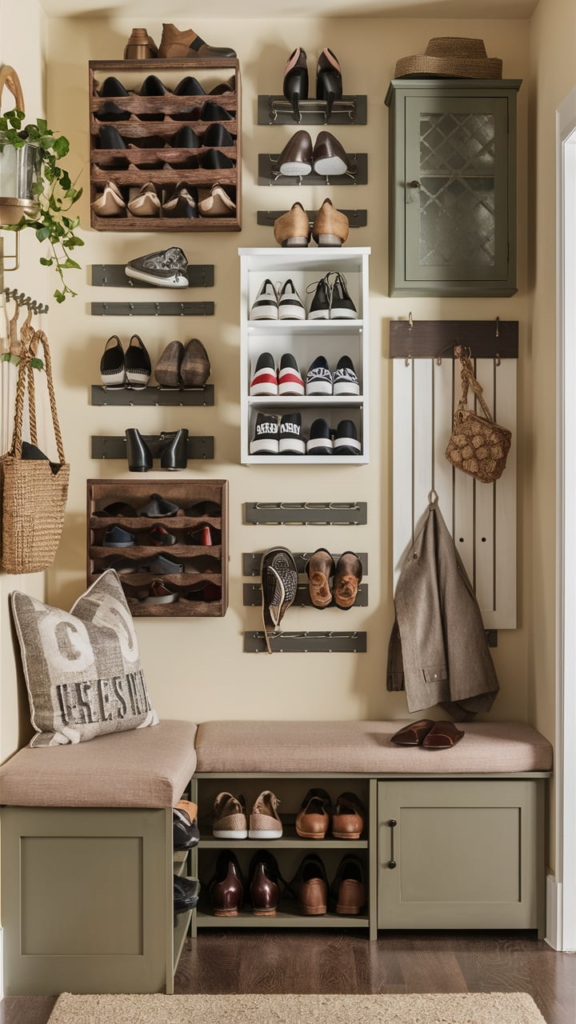
Entryway Closets with Shoe Storage
Efficient and Organized Entryways
Entryway closets with shoe storage are an excellent solution for keeping your home organized and your footwear accessible. These closets integrate shoe storage within your entryway space, combining functionality with style. By designing your entryway closet with built-in shoe storage solutions, you can streamline your daily routine and create a welcoming and tidy entrance to your home.
Design and Installation Ideas
- Custom Built-In Shelving
How-To: Install custom-built shelving units within your entryway closet to accommodate shoes. These shelves can be designed to fit the exact dimensions of your closet and have adjustable heights to accommodate various shoe sizes. For added versatility, include a mix of open shelves and closed compartments.
Benefits: Custom built-in shelving maximizes available space and allows for a tailored solution that meets your needs. It provides a sleek and organized look, integrating seamlessly with your closet design.
- Pull-Out Shoe Racks
How-To: Incorporate pull-out shoe racks or drawers into your entryway closet design. These racks can be mounted on sliding tracks, allowing you to access your shoes easily without reaching deep into the closet. Choose racks with adjustable dividers to accommodate different types of footwear.
Benefits: Pull-out racks offer easy access and keep your shoes organized. They help maintain a clutter-free appearance and make it simple to find the pair you need quickly.
- Shoe Cubbies
How-To: Design your entryway closet with shoe cubbies or compartments. Each cubby can store a specific pair of shoes, making organizing and locating your footwear easy. Use cubbies of varying sizes to accommodate different shoe styles and accessories.
Benefits: Shoe cubbies provide clear, designated spaces for each shoe pair, helping keep your closet neat and organized. They also offer a visually appealing and structured storage solution.
- Bench with Shoe Storage
How-To: Incorporate a bench with built-in shoe storage into your entryway closet design. The bench can feature open shelves or drawers underneath for storing shoes, while the top provides a convenient seating area for putting on or taking off shoes.
Benefits: A bench with shoe storage offers practical and multifunctional seating with storage, enhancing the functionality of your entryway closet.
- Overhead Storage
How-To: Utilize the upper portion of your entryway closet for overhead shoe storage. Install high shelves or cabinets to store seasonal footwear or items that are not used frequently. Use clear bins or baskets to keep the area organized.
Benefits: Overhead storage maximizes vertical space and keeps less frequently used shoes out of the way. It helps maintain a tidy appearance in the lower portion of the closet.
Design and Aesthetic Considerations
- Space Planning: Assess the dimensions of your entryway closet and plan the layout of your shoe storage accordingly. Consider the space’s depth, width, and height to ensure that your storage solutions fit well.
- Materials and Finishes: Choose materials and finishes that complement the spaces of your entryway. Wood, laminate, and metal are popular choices that offer durability and aesthetic appeal. Opt for finishes that match or enhance your existing decor.
- Lighting: Ensure that your entryway closet is well-lit to make finding and accessing your shoes easier. Consider installing LED lighting or adding a light fixture inside the closet.
Installation Tips
- Measure Accurately: Carefully Measure your entryway closet’s dimensions before purchasing or installing storage solutions. This ensures that your shoe storage fits perfectly and functions as intended.
- Inscloset’sperly: Follow manufacturer instructions or hire a professional to ensure your shoe storage is securely mounted and functions smoothly.
- Consider Accessibility: Design your entryway closet to ensure all storage areas are easily accessible. Avoid placing shelves or racks too high or too low, and ensure that pull-out mechanisms operate smoothly.
Maintenance and Care
- Regular Cleaning: Keep your entryway closet and shoe storage areas clean and dust-free. Wipe down shelves, cubbies, and racks regularly with a damp cloth.
- Check for Wear: Inspect your shoe storage components periodically for signs of wear or damage. Repair or replace any damaged parts to maintain the functionality and appearance of your closet.
Benefits of Entryway Closets with Shoe Storage
Entryway closets with shoe storage offer an efficient and organized solution for footwear management. They enhance the functionality of your entryway, keep your home clutter-free, and provide easy access to your shoes. By integrating shoe storage into your entryway closet, you create a practical and stylish space that improves your home’s overall organization and aesthetics.
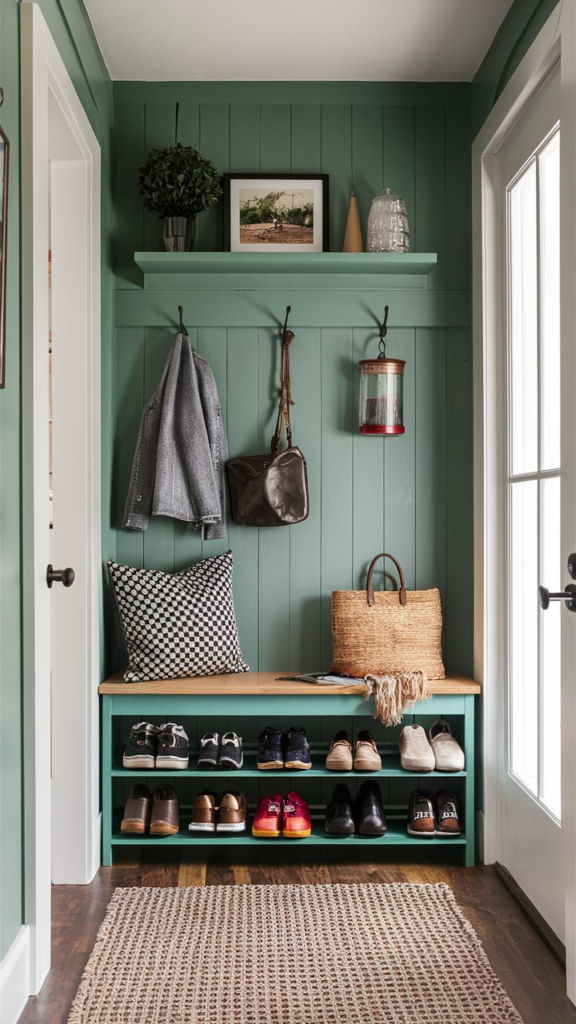
Personalized Shoe Storage Solutions
Tailoring Storage to Your Needs
Personalized shoe storage solutions offer a unique approach to organizing footwear by customizing the storage to fit your specific needs, preferences, and lifestyle. Whether you have an extensive shoe collection or just a few favorite pairs, personalized solutions ensure that your shoes are stored efficiently, are easily accessible, and align with your home’s decor. Here’s how to create a shoe storage system tailored just for you.
1. Custom Cabinetry
How-To: Design and install custom cabinetry in your entryway, home, or anywhere else you need shoe storage. Work with a designer or cabinet maker to create units that fit your measurements and storage requirements. Include features such as adjustable shelves, built-in drawers, and dedicated compartments for different types of shoes.
Benefits: Custom cabinetry maximizes space and allows for a tailored storage solution. It ensures that every shoe pair has its designated place, reducing clutter and enhancing organization.
2. Modular Storage Systems
How-To: Use modular storage systems that can be customized and reconfigured based on your needs. These systems often include components like cubbies, shelves, and baskets that can be arranged in various ways. Choose modular units that can be expanded or rearranged as your shoe collection grows or changes.
Benefits: Modular storage systems offer flexibility and adaptability. They can be easily adjusted to fit changing needs and preferences, making them ideal for evolving shoe collections.
3. Shoe Closet Design
How-To: Create a dedicated shoe closet customized to your specifications. Incorporate features like pull-out racks, built-in lighting, and climate control options to protect and organize your footwear. Include adjustable shelving and compartments to accommodate different shoe styles and sizes.
Benefits: A dedicated shoe closet provides ample space and a specialized environment for storing your shoes. It enhances accessibility and allows for organized and efficient storage.
4. Customized Shoe Racks
How-To: Design and build customized shoe racks to fit specific spaces in your home. These racks can be tailored to match your decor and include tiered shelving, rotating sections, or integrated seating. Consider using materials that complement your existing furniture.
Benefits: Customized shoe racks offer a personalized touch and ensure the storage solution fits perfectly within your space. They can be designed to enhance both functionality and aesthetics.
5. Personalized Shoe Bins and Baskets
How to use personalized bins and baskets for shoe storage. Customize these containers with labels, colors, or patterns that reflect your style. Choose bins that fit your shelving or closet dimensions, and consider adding dividers or compartments for organization.
Benefits: Personalized bins and baskets add a decorative element to your storage while keeping your shoes organized. They allow you to match your storage solutions with your home’s decor.
6. Shoe Storage Understairs
How-To: Customize the space under your stairs for shoe storage. Create built-in shelves, cubbies, or drawers that fit the unique dimensions of this area. Include sliding doors or pull-out sechome’sto make the space more functional.
Benefits: Utilizing under-stair space for shoe storage is an efficient way to use otherwise wasted space. Customizing this area ensures that it meets your storage needs and integrates seamlessly with your home.
7. Interactive Shoe Storage Solutions
How-To: Incorporate interactive elements into your shoe storage, such as intelligent technology or adjustable components. Consider using app-controlled lighting, motion-activated shelves, or automated drawers that make accessing your shoes more convenient.
Benefits: Interactive storage solutions offer modern, high-tech options that enhance convenience and functionality. They add a unique touch to your storage setup and improve the user experience.
Design and Aesthetic Considerations
- Material Selection: Choose materials that complement your home’s decor. Options include wood, metal, glass, and high-quality laminates. Each material offers different benefits regarding durability, appearance, and maintenance.
- Color and Finish: Select shades and finishes that blend or enhance your decor. Neutral tones phome’s a classic look, while bold colors can make a statement.
- Lighting: Ensure that your personalized shoe storage solutions are well-lit. Incorporate built-in lighting or place storage in well-lit areas to make finding and accessing your shoes easier.
Installation Tips
- Professional Consultation: Consult a professional designer or carpenter to ensure your personalized shoe storage solutions are well-designed and installed correctly.
- Measure Accurately: Measure your space precisely to ensure that custom storage solutions fit perfectly. Account for any irregularities or obstacles in the space.
- Functionality: In your design, prioritize functionality and ease of access. Ensure all components are easy to use and the storage meets your needs.
Maintenance and Care
- Regular Cleaning: Regularly clean your personalized shoe storage to maintain its appearance and functionality. Wipe down shelves, racks, and bins with a damp cloth.
- Inspect for Damage: Periodically check your storage solutions for signs of wear or damage. Repair or replace damaged parts to keep the storage system in good condition.
Benefits of Personalized Shoe Storage Solutions
Personalized shoe storage solutions provide a tailored approach to organizing your footwear. They enhance functionality, improve accessibility, and align with your style and home decor. By investing in customized storage, you create a practical and aesthetically pleasing space, making it easier to maintain an organized and clutter-free home.
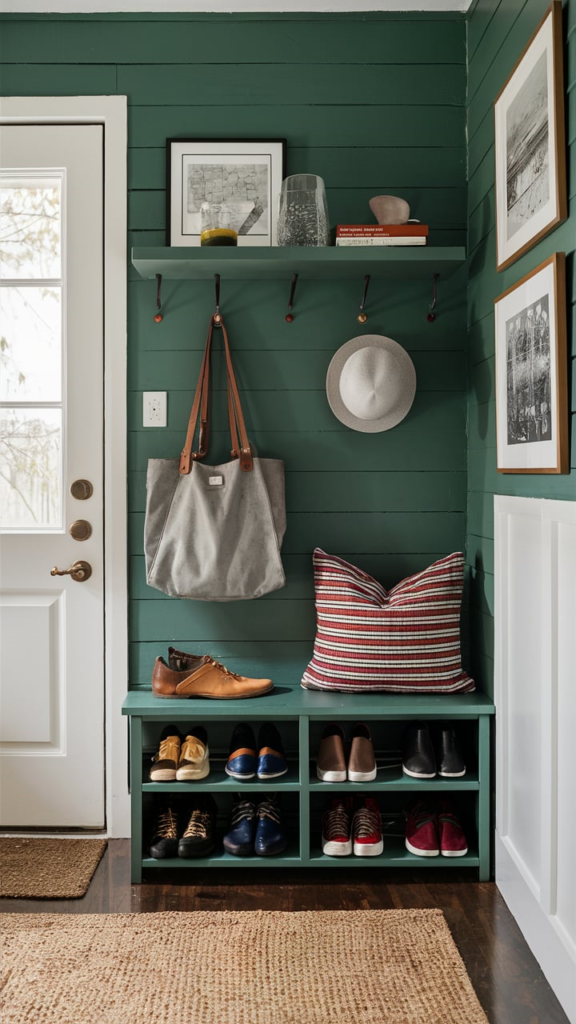
Personal Opinion: The Best Shoe Storage Solutions for Modern Homes
A Modern Approach to Shoe Organization
In the ever-evolving world of home design, modern homes demand storage solutions that are not only functional but also stylish and adaptable. Shoe storage is no exception. With the trend towards minimalism and intelligent living, modern home shoe storage solutions blend practicality with aesthetics, ensuring that footwear is organized without compromising design. Here’s my take on the most effective shoe storage solutions that cater to contemporary tastes and needs.
1. Custom Cabinetry: The Pinnacle of Personalization
Why It Works: Custom cabinetry is the top choice for modern homes because it offers a tailored approach to shoe storage. Unlike off-the-shelf solutions, custom cabinets are designed to fit the exact dimensions of yourHere’s, allowing for optimal use of available rooms. This level of personalization ensures that your storage solution not only fits perfectly but also meets your specific organizational needs.
Advantages: The main advantage of custom cabinetry is its flexibility. You can choose from various materials, finishes, and configurations to match your home’s decor and style. Additionally, built-in features such as adjustable shelves and pull-out racks enhance functionality, making it easier to access and store your shoes.
2. Modular Storage Systems: Flexibility Meets Modern Design
Why It Works: Modular storage systems are ideal for modern homes due to their adaptability and sleek design. These systems allow you to customize the layohome’s reconfigure components, perfect for evolving shoe collections and changing household needs.
Advantages: The primary benefit of modular systems is their versatility. You can start with a basic setup and expand or modify it over time. This flexibility is especially useful in modern homes where space and needs change frequently. Modular systems often feature a clean, minimalist design that complements contemporary interiors.
3. Wall-Mounted Solutions: Maximizing Vertical Space
Why It Works: Wall-mounted shoe racks and shelving are excellent for modern homes because they use vertical space that might otherwise be wasted. This approach aligns with the minimalist trend of reducing clutter and maximizing functionality in smaller spaces.
Advantages: Wall-mounted solutions offer a sleek, discreet way to store shoes while keeping the floor area clear. They are instrumental in entryways or small closets where space is premium. Additionally, they can be designed to integrate seamlessly with the existing decor, providing a modern and streamlined look.
4. Rotating Shoe Racks: Innovative and Space-Efficient
Why It Works: Rotating shoe racks perfectly fit modern homes that value innovation and efficiency, these racks allow for compact storage while providing easy access to many shoes.
Advantages: The main benefit of rotating racks is their space efficiency. They can store significant footwear in a small footprint, making them ideal for homes with limited space. The rotating feature also adds a modern touch, making it easier to access all your shoes with a simple turn.
5. Shoe Storage Ottomans: Dual-Purpose Furniture
Why It Works: Shoe storage ottomans are an excellent choice for modern homes prioritizing multimultifunctionaliture. Multifunctional combine shoe storage with seating, making them practical and stylish.
Advantages: Storage ottomans’ dual-purpose nature makes them a valuable addition to modern homes. They provide a convenient place to sit while putting on or removing shoes, and the hidden storage keeps footwear organized and multifunctional in entryways or living areas where space is limited.
6. Personalized Solutions: Tailoring to Individual Needs
Why It Works: Personalized shoe storage solutions are ideal for modern homes because they offer a bespoke approach to organization. Customizing storage to fit your specific needs and preferences allows you to create a solution that perfectly complements your lifestyle.
Advantages: Personalized solutions allow for a high degree of customization, ensuring your storage setup is functional and aesthetically pleasing. This approach is precious in modern homes where design and functionality must align seamlessly. Custom options can include built-in lighting, climate control, and interactive features, adding a high-tech touch to your storage.
Conclusion
The best shoe storage solutions for modern homes blend functionality with contemporary design. Custom cabinetry, modular systems, wall-mounted racks, rotating racks, storage ottomans, and personalized solutions each offer unique benefits that cater to the needs of modern living. By selecting the proper storage solution, you can maintain an organized and stylish home while keeping your footwear easily accessible.
In my opinion, the ideal shoe storage solution integrates seamlessly with your home’s design while providing practical and efficient storage. Custom and modular options stand out for their adaptability and style, while wall-mounted and rotating racks offer innovative space-saving solutions. Ultimately, the best choice depends on your needs, space constraints, and design preferences. Investing in a well-designed shoe storage solution enhances your modern home’s functionality and aesthetics.
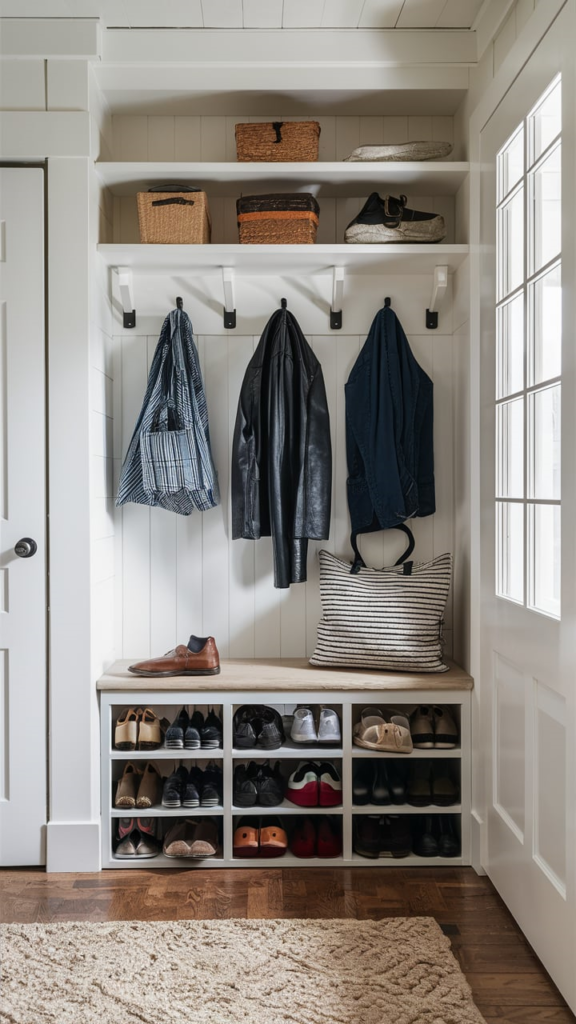
FAQ: Shoe Storage Solutions
1. What are the benefits of using wall-mounted shoe racks?
Wall-mounted shoe racks maximize vertical space, keeping the floor area clear and reducing clutter. They are instrumental in smaller spaces or entryways with limited floor space. Additionally, they provide a sleek and modern look that integrates well with contemporary home decor.
2. How do modular shoe storage systems work?
Modular shoe storage systems consist of individual components such as shelves, cubbies, and bins that can be arranged and reconfigured according to your needs. This flexibility allows you to customize the layout and expand or adjust the system as your shoe collection grows or changes. Modular systems are adaptable and can fit various spaces and styles.
3. What are the advantages of rotating shoe racks?
Rotating shoe racks offers space efficiency by storing many shoes in a compact area. Their rotating feature allows for easy access to all footwear with a simple turn, making them a convenient solution for organizing and retrieving shoes. They are particularly beneficial in homes with limited space.
4. How can personalized shoe storage solutions improve the organization?
Personalized shoe storage solutions are tailored to fit your needs, preferences, and space constraints. By customizing the design, you can ensure that your shoe storage is functional and aesthetically pleasing. Features such as adjustable shelves, built-in lighting, and climate control can enhance the organization and protection of your footwear.
5. What should I consider when designing a custom shoe cabinet?
When designing a custom shoe cabinet, consider the size and layout of your space, the number and types of shoes you own, and your style preferences. Choose materials and finishes that complement your home’s decor and include features like adjustable shelves, pull-out racks, and built-in lighting to enhance functionality and organization.
6. Are there space-saving solutions for shoe storage in tiny homes?
Several space-saving solutions exist for tiny homes, including wall-mounted racks, under-stair storage, rotating shoe racks, and modular systems. These options maximize available space and reduce clutter while keeping your shoes organized and accessible. Compact and multi-fmultifunctionalure, such as multifumultifunctionalure ottomans, can also be helpful in small spaces.
7. How do I maintain and care for my shoe storage solutions?
To maintain and carehome’sour shoe storage solutions, regularly clean the surfaces with a damp cloth, check for any signs of wear or damage, and make necessary repairs. For materials like wood or metal, follow specific cleaning and maintenance instructions to preserve their appearance and functionality. Ensure all components function properly and adjust any movmultifunctionaleded.
8. What are the benefits of using shoe storage ottomans?
Shoe storage ottomans provide a dual-purpose solution by combining seating with hidden shoe storage. This makes them a practical choice for entryways or living areas where space is limited. They offer a convenient place to sit while putting on or removing shoes, and the hidden compartments keep footwear organized and out of sight.
9. Can DIY shoe storage solutions be as effective as store-bought options?
Yes, DIY shoe storage solutions can be highly effective and customizable. You can tailor your storage solutions to fit your specific space and style preferences by creating your storage solutions. DIY options can be cost-effective and offer a unique touch that complements your home’s decor. However, ensure that DIY solutions are built securely and functionally to avoid issues.
10. How do I choose the best shoe storage solution for my home?
Choosing the best shoe storage solution depends on factors such as the size of your space, the number of shoes you have, and your design preferences. Consider options that maximize space, offer easy access, and complement your home’s decor. Custom and modular solutions provide flexibility and personalization, while wall-mounted and rotating racks offer innovative and space-saving features. Evaluate your needs and select a solution that balances functionality with style.

Conclusion
Optimhome’sShoe Storage for Modern Living
Efficient shoe storage is more than just a matter of organization; it’s a critical element of creating a functional and aesthetically pleasing living space. Choosing the proper shoe storage solutions can make a significant difference in modern homes, where design and practicality must seamlessly blend. The options we’ve explored, from custom cabinetry and mohome’ssystems to wall-mounted racks and innovative rotating racks, offer various ways to tailor your shoe storage to fit your specific needs and style.
Key Takeaways:
- Custom Cabinetry provides a bespoke approach, allowing you to optimize space and create a storage solution that perfectly matches your home’s design and organizational needs.
- Modular Systems: Offer fleit’slity and adaptability, making them ideal for evolving shoe collections and changing household requirements.
- Wall-Mounted Racks: Utilize vertical space efficiently, helping to keep floors clear and reducing clutter in smaller areas.
- Rotatingwe’ves: Combine space-saving with easy access, making them perfect for homes with limited floor space.
- Storage Ottomans: Provide a dual-purpose solution, combining seating with hidden storage to maximize functionality in tight spaces.
- Personalized Solutions: Ensure that your storage is practical, complements your home’s decor, and meets your needs.
In Summary:
The best shoe storage solution for your modern home will depend on your unique space, style, and requirements. Whether you opt for a high-tech, customizable system or a sleek, minimalist design, the key is to find a solution that enhances your home’s functionality and aesthetic appeal. Investing in thoughtful, well-designed shoe storage will create a more organized, efficient, and stylish living environment.
By considering these options and evaluating your specific needs, you can select the perfect shoe storage solution that keeps your footwear neatly organized and enhances the overall ambiance of your home. In the home’s world of modern design, the right choice will ensure that your home remains a harmonious blend of practicality and elegance.


